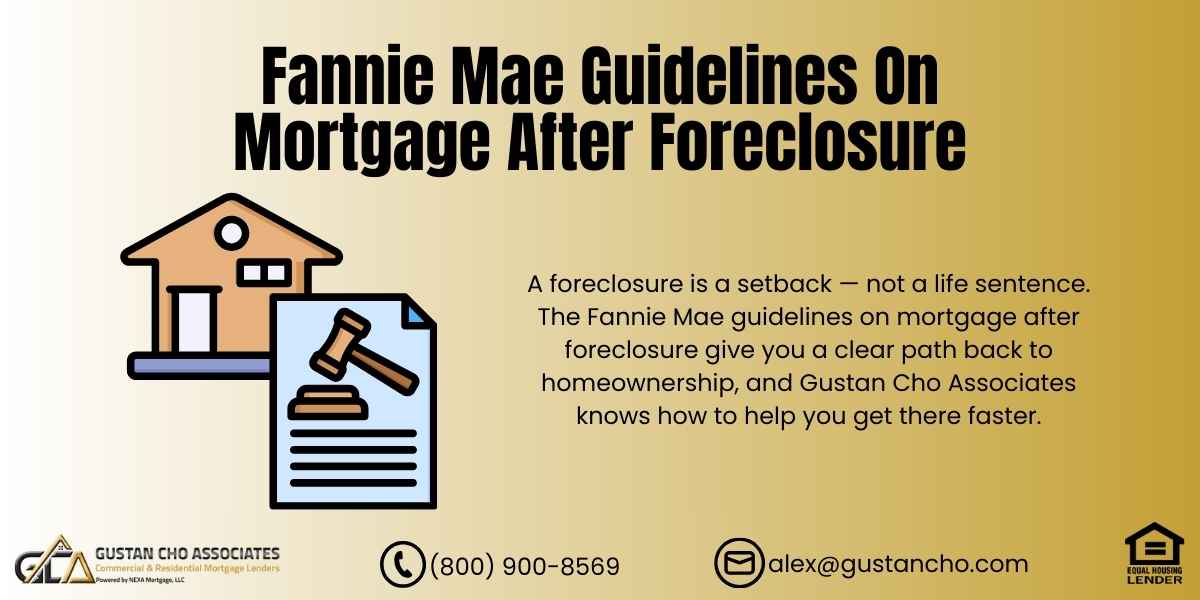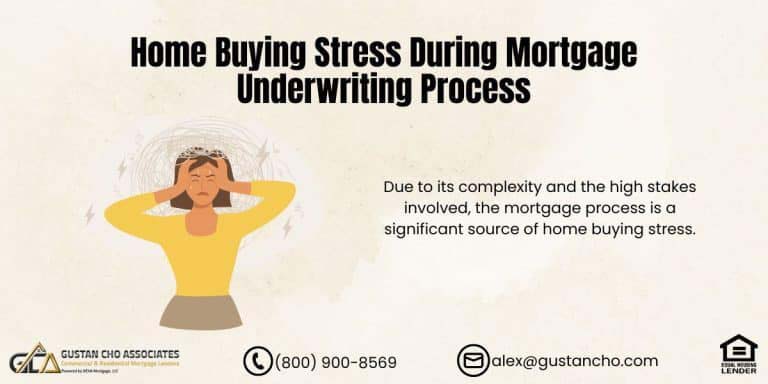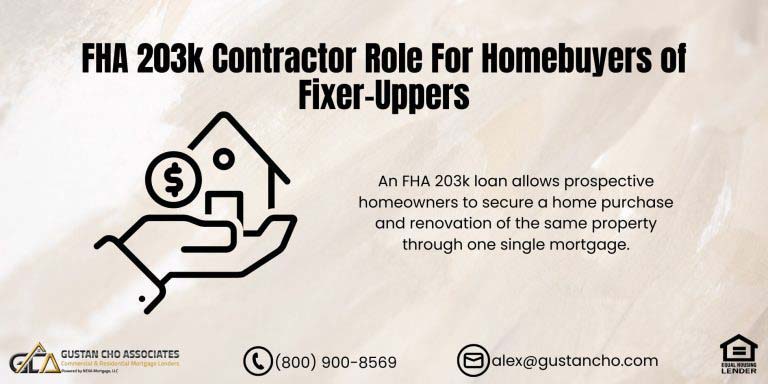Fannie Mae Guidelines on Mortgage After Foreclosure in 2025: How to Qualify Again Fast
If you’ve been through a foreclosure, you might wonder: “When can I buy a house again?” The good news is you can, and knowing the Fannie Mae guidelines on mortgage after foreclosure is the first step.
At Gustan Cho Associates, we specialize in helping borrowers who thought they had to wait forever to get a mortgage. Even if you’ve been turned down by other lenders, our team knows how to navigate the rules so you can own a home again.
In this guide, we’ll summarize everything you need to know about Fannie Mae guidelines on mortgage after foreclosure in 2025 — from waiting periods to special exceptions — in plain language.
Why Fannie Mae Guidelines on Mortgage After Foreclosure Matter
Fannie Mae is one of the two leading “mortgage giants” that set the rules for conventional loans (the other is Freddie Mac). If you want a conventional loan, your application must meet Fannie Mae’s guidelines before approval.
When you’ve had a foreclosure, deed in lieu, or short sale, Fannie Mae sets specific waiting periods before you can qualify for another mortgage. These rules differ from FHA, VA, and USDA loans, so knowing the exact timelines is important.
Understanding the Fannie Mae guidelines on mortgage after foreclosure will help you confidently plan your next home purchase — and avoid wasting time with lenders who don’t know the exceptions.
Ready to Buy Again After Foreclosure?
Learn Fannie Mae’s waiting periods and guidelines so you can plan your next move.
How Long After Foreclosure Can You Get a Mortgage With Fannie Mae?
Fannie Mae requires different waiting periods depending on the type of housing event you experienced.
Here are the 2025 rules:
- Foreclosure: 7 years from the date the foreclosure is recorded (not when you moved out).
- Deed in Lieu of Foreclosure: 4 years from the recorded date.
- Short Sale: 4 years from the closing date listed on your settlement paperwork.
These timelines are non-negotiable unless you qualify for an exception, such as extenuating circumstances (we’ll cover that shortly).
Pro Tip from Gustan Cho Associates: Many borrowers think their waiting period started years ago, only to find out the bank didn’t officially record the foreclosure until much later. That recorded date is what matters.
Waiting Period Start Date: Why the Recorded Date Matters
Many people misunderstand when the timeline begins regarding Fannie Mae guidelines on mortgage after a foreclosure. The clock actually starts on the recorded date when the foreclosure or deed in lieu is finalized in the county records, which is typically the date of the sheriff’s sale or trustee sale. It’s important to note that this timeline does not start when you return the keys, move out, or cease making payments.
This means if your bank delayed recording the foreclosure for years, your waiting period might still be running — even if you’ve been out of the house for a long time.
At Gustan Cho Associates, we help clients track down the exact recorded date so you know your real timeline.
Short Sale Waiting Period Rules
If you sold your home in a short sale — where the lender accepted less than the amount owed — the waiting period is shorter than foreclosure.
Under the Fannie Mae guidelines on mortgage after foreclosure, a short sale has a 4-year waiting period, starting from the date on your closing paperwork (Closing Disclosure).
Special Rule: Mortgage Included in Bankruptcy
Fannie Mae has a unique exception for borrowers whose mortgage was included in a Chapter 7 bankruptcy.
Here’s how it works:
- The waiting period is 4 years from the bankruptcy discharge date, even if the foreclosure was recorded later.
- The mortgage must have been included in the bankruptcy filing.
- You cannot have reaffirmed the mortgage during bankruptcy.
This rule is huge because it can save borrowers years of waiting time compared to FHA or VA guidelines.
At Gustan Cho Associates, we see this mistake all the time: borrowers think they have to wait 7 years after foreclosure when they actually qualify in 4 years because their mortgage was discharged in bankruptcy.
Foreclosure Doesn’t Mean Forever
Understand the 2025 Fannie Mae rules for getting a mortgage after foreclosure.
Extenuating Circumstances: Can You Shorten the Waiting Period?
Yes — but it’s rare. If you can prove extenuating circumstances, Fannie Mae allows a shorter waiting period (3 years for foreclosure, 2 years for deed in lieu or short sale).
Examples include:
- Serious illness or disability
- Death of the primary wage earner
- Other unavoidable financial hardship beyond your control
You’ll need strong documentation to qualify for this exception; not all lenders allow it. Gustan Cho Associates works with wholesale lenders who will consider these cases.
How Fannie Mae Differs From FHA, VA, and USDA After Foreclosure
While this article focuses on Fannie Mae guidelines on mortgage after foreclosure, it’s helpful to compare them to government-backed loans:
- FHA: 3 years after the recorded foreclosure date
- VA: 2 years after the recorded foreclosure date
- USDA: 3 years after the recorded foreclosure date
If you want to buy sooner than 4–7 years, FHA or VA loans may be a better short-term option — and Gustan Cho Associates can help you compare them side-by-side.
Why Gustan Cho Associates Is Different
Many banks add lender overlays — extra rules beyond Fannie Mae’s minimum guidelines. They might tell you you’re not eligible for 10 years after foreclosure when the official rule is 7 years.
At Gustan Cho Associates, we have no lender overlays on conventional loans. If you meet the Fannie Mae guidelines on mortgage after foreclosure, we can get you approved — even if other lenders said no.
We also:
- Work in 50 states, including DC, Puerto Rico, Guam, and the U.S. Virgin Islands
- Offer same-day pre-approvals
- Have access to 280+ wholesale lenders for the best rates and programs
Steps to Qualify for a Conventional Loan After Foreclosure
If you’re ready to buy again, here’s how to move forward:
1. Find Your Recorded Date
Get a copy of the foreclosure, deed in lieu, or short sale recording from your county records.
2. Check Your Credit Report
Make sure the housing event is reported correctly. Dispute any errors before applying.
3. Meet Credit and DTI Requirements
Most Fannie Mae loans require a minimum credit score of 620 (though higher scores may get better rates) and acceptable debt-to-income ratios.
4. Save for Down Payment
Conventional loans usually require at least 3–5% down, depending on your situation.
5. Work With a No-Overlay Lender
Gustan Cho Associates will ensure your file meets Fannie Mae guidelines on mortgage after foreclosure without unnecessary extra rules.
Common Mistakes Borrowers Make
- Assuming the waiting period started when they moved out.
- Applying with a bank that has stricter rules than Fannie Mae.
- Forgetting to check if their mortgage was included in bankruptcy.
- Waiting longer than necessary because they didn’t know the exceptions.
2025 Update: What’s New in Fannie Mae Guidelines
As of 2025, the core waiting periods in the Fannie Mae guidelines on mortgage after foreclosure have not changed from prior years. However:
- Lenders are using Desktop Underwriter® (DU) more aggressively to approve borderline cases.
- Credit score requirements remain at 620 minimum, but higher scores can help offset a past foreclosure.
- Interest rates for post-foreclosure borrowers are often slightly higher, but competitive shopping through wholesale channels (like ours) can close that gap.
Fast-Track Your Return to Homeownership
Discover exceptions and strategies to buy sooner after foreclosure.
Final Thoughts: You Can Buy Again
A foreclosure is a setback — not a life sentence. The Fannie Mae guidelines on mortgage after foreclosure give you a clear path back to homeownership, and Gustan Cho Associates knows how to help you get there faster.
Whether your waiting period is over or you think it might be, we can review your timeline, check for bankruptcy exceptions, and get you pre-approved.
Borrowers who need a five-star national mortgage company licensed in 50 states with no overlays and who are experts on Fannie Mae guidelines on mortgage after foreclosure, please contact us at 800-900-8569, text us for a faster response, or email us at alex@gustancho.com.
We’re available 7 days a week, evenings, weekends, and holidays to help you become a homeowner again.
Frequently Asked Questions About Fannie Mae Guidelines on Mortgage After Foreclosure:
Q: What are the Fannie Mae Guidelines on Mortgage After Foreclosure?
A: They are the official rules Fannie Mae uses to decide when you can get a conventional mortgage again after a foreclosure, deed in lieu, or short sale.
Q: How Long do I have to Wait After Foreclosure Under the Fannie Mae Guidelines?
A: You must wait 7 years from the date the foreclosure is recorded in county records — not the date you moved out.
Q: Do the Fannie Mae Guidelines on Mortgage After Foreclosure have Shorter Waiting Times for a Deed in Lieu or Short Sale?
A: Yes. A deed in lieu or short sale lasts four years, starting from the recorded date or your closing paperwork date.
Q: What if My Mortgage was Included in Bankruptcy Under the Fannie Mae Guidelines on Mortgage After Foreclosure?
A: You may qualify in just 4 years from your bankruptcy discharge date, even if the foreclosure was recorded later.
Q: Can the Fannie Mae Guidelines on Mortgage After Foreclosure be Shortened for Special Situations?
A: Yes, if you have “extenuating circumstances” like a serious illness, disability, or death of the primary income earner. This can reduce the wait to 3 years for foreclosure or 2 years for deed in lieu/short sale.
Q: When Does the Waiting Period Start Under the Fannie Mae Guidelines on Mortgage After Foreclosure?
A: It starts when the foreclosure or deed in lieu is officially recorded in county records, not when you stop paying or move out.
Q: How do the Fannie Mae Guidelines on Mortgage After Foreclosure Compare to Those of the FHA, VA, and USDA?
A: FHA requires 3 years, VA requires 2 years, and USDA requires 3 years — so they may be faster than Fannie Mae’s 4–7 years.
Q: Do All Lenders Follow the Fannie Mae Guidelines on Mortgage After Foreclosure Exactly?
A: No. Many lenders add “overlays,” which are extra rules. Some may require you to wait longer.
Q: What Credit Score do I Need Under the Fannie Mae Guidelines for a Mortgage After Foreclosure?
A: Usually at least 620, but a higher score can help you get a better rate and approval.
Q: How can Gustan Cho Associates help with the Fannie Mae guidelines on mortgage after foreclosure?
We have no overlays, work in all 50 states, and know how to find exceptions that could help you qualify sooner.
This article about ”Fannie Mae Guidelines On Mortgage After Foreclosure” was updated on August 12th, 2025.
From Foreclosure to New Keys in Hand
Fannie Mae’s guidelines may allow you to buy again sooner than you think.











Fannie Mea in Florida Stole a house from my daughter and me cause of her dad’s death.
They never allowed her and me a chance to pay a small mortgage left. One year before his death the house was only worth 70,000 and when he died the house was worth 124,000 so they wanted that profit and literly denied my daughter and me a chance to pay what was owed, even though there was a special deed saying I could help save the house and that was even in my devorce papers. But Fannie mea wanted to make a profit off the death of my daughter’s father and my ex husband. The lawyer involved even allowed a family member go into house and steal everything in house. There are several complaints filed and we won’t let Fannie mea steal from us.